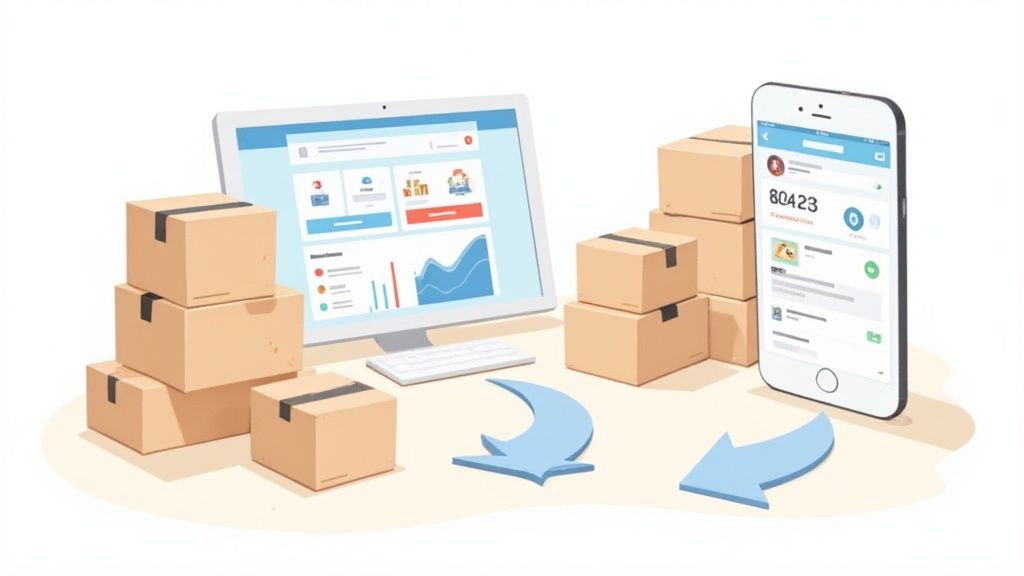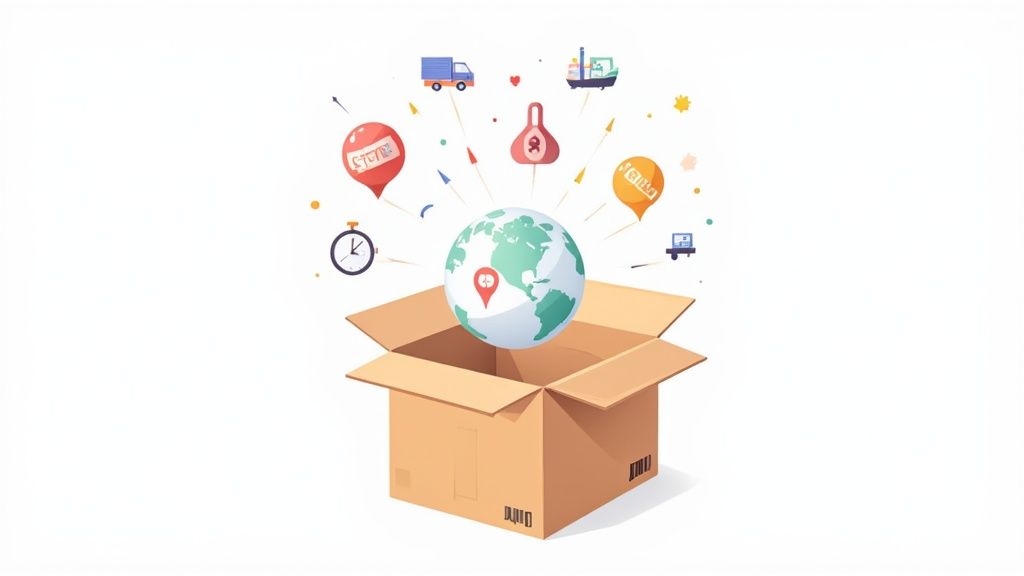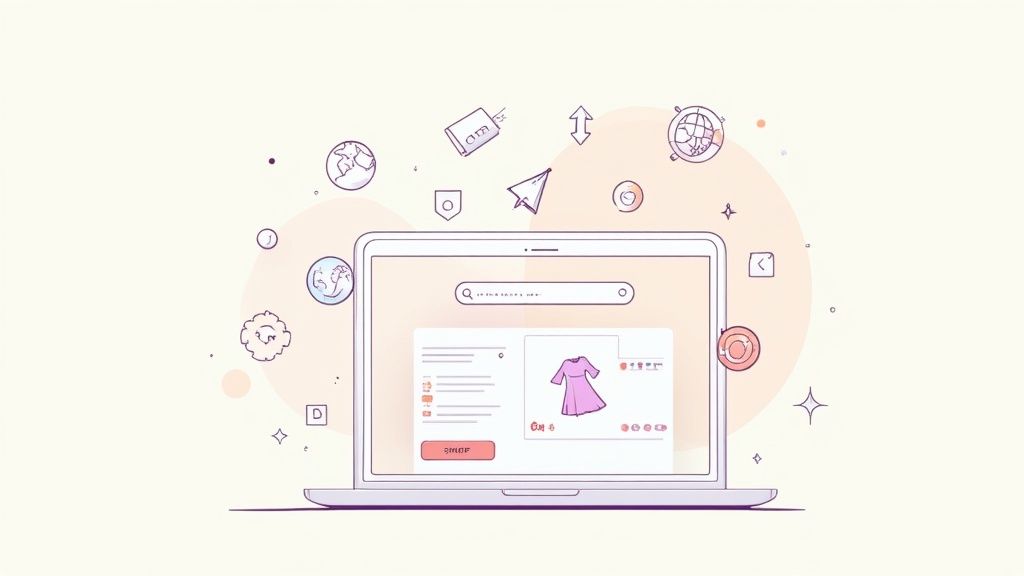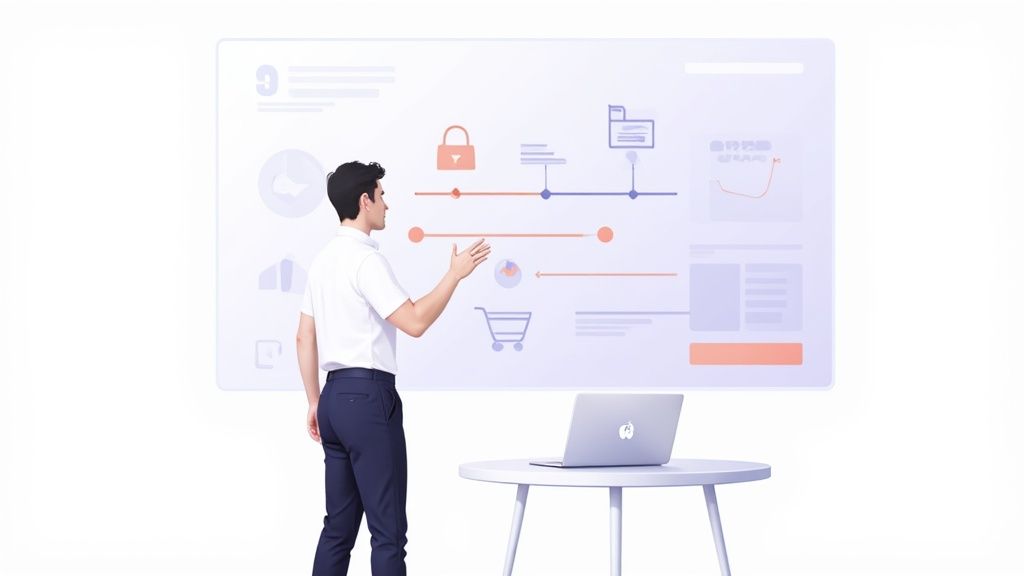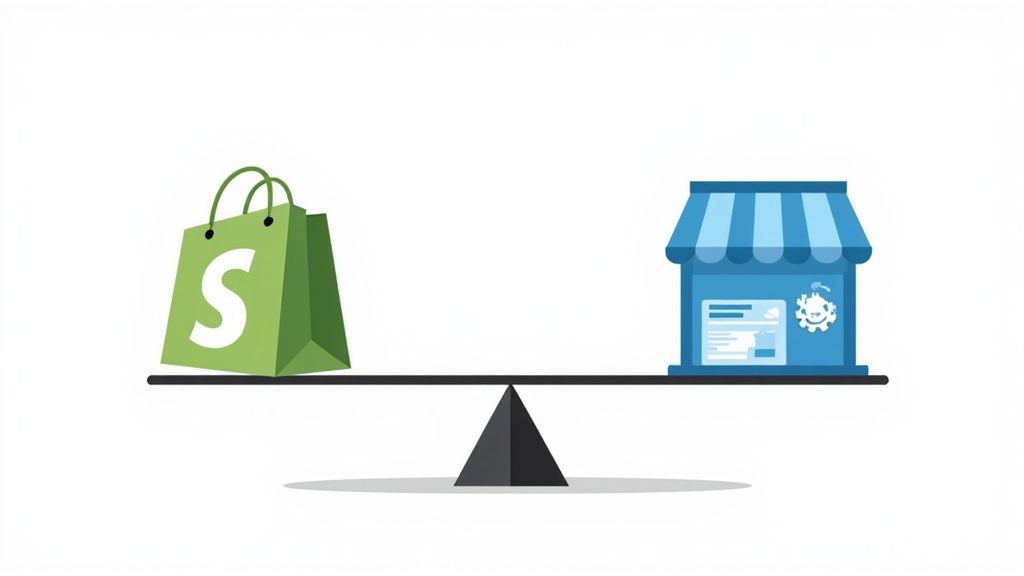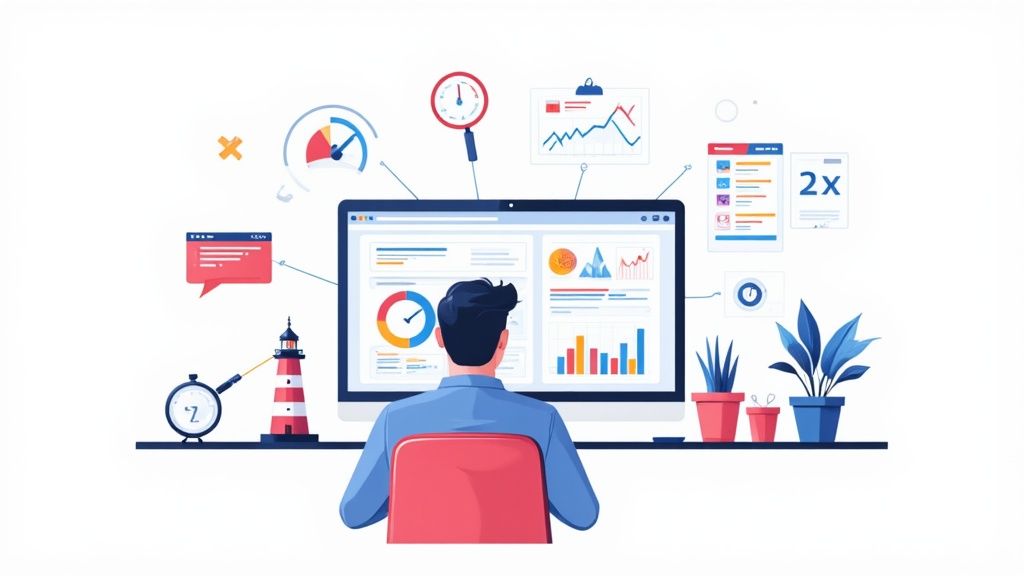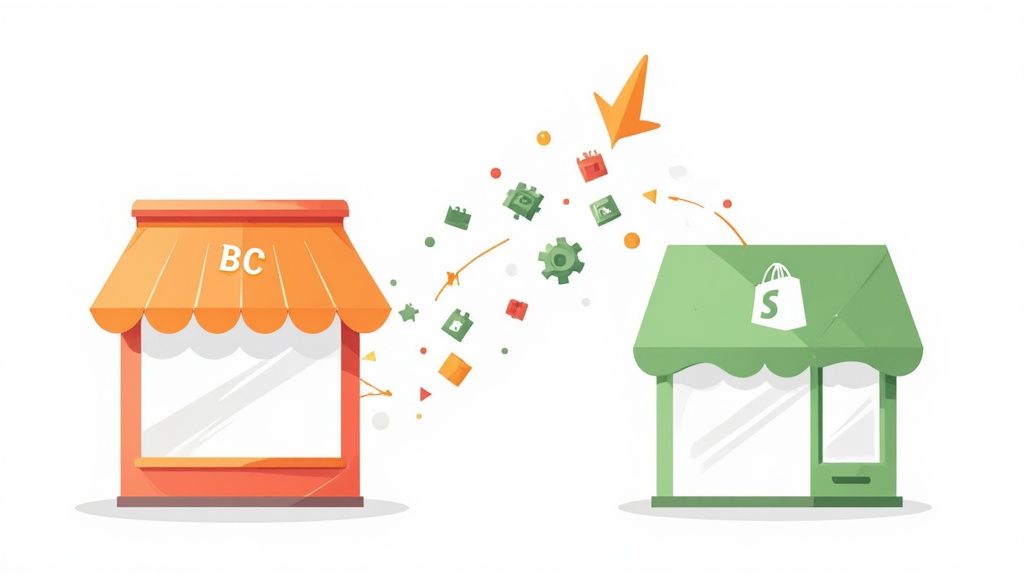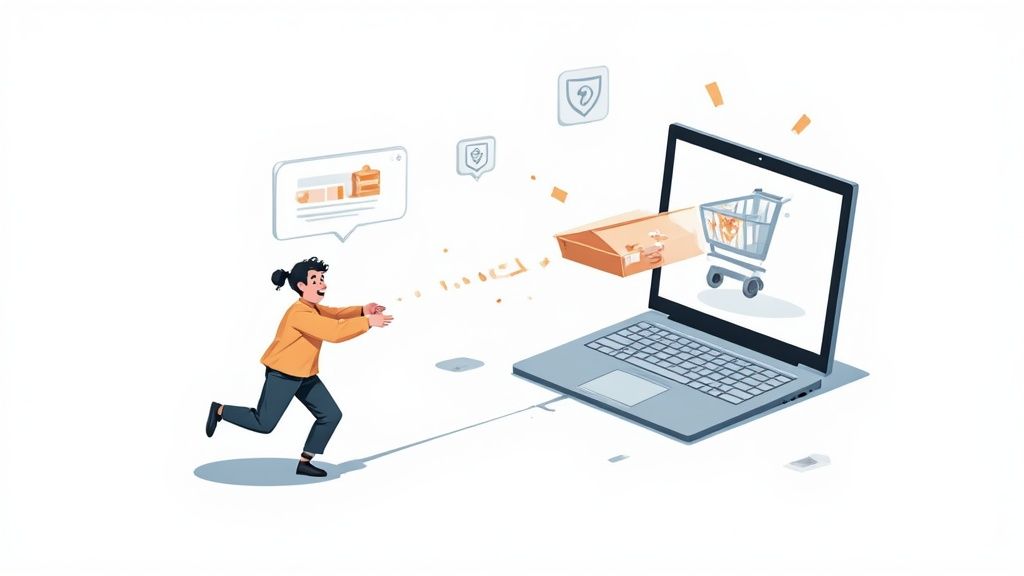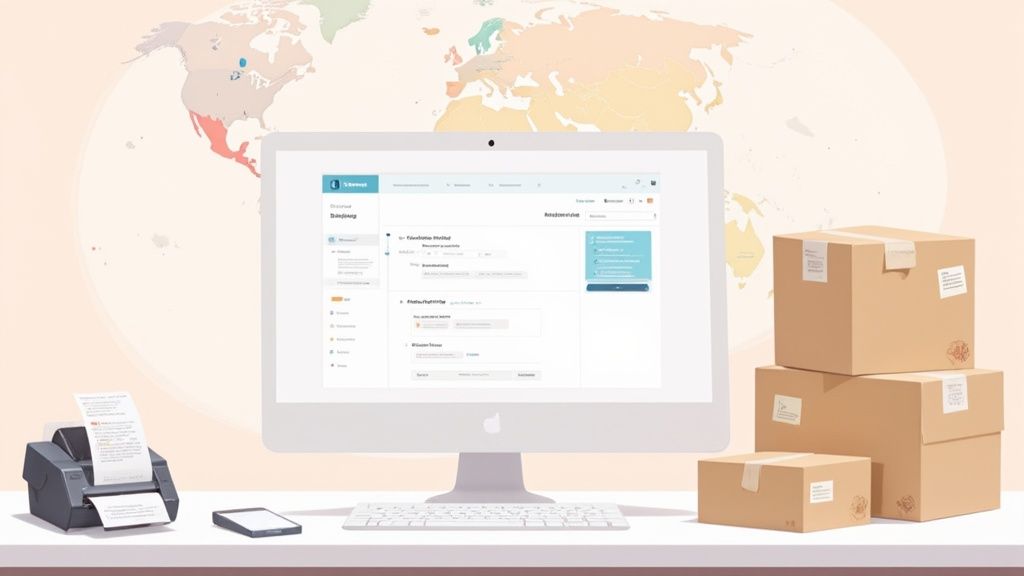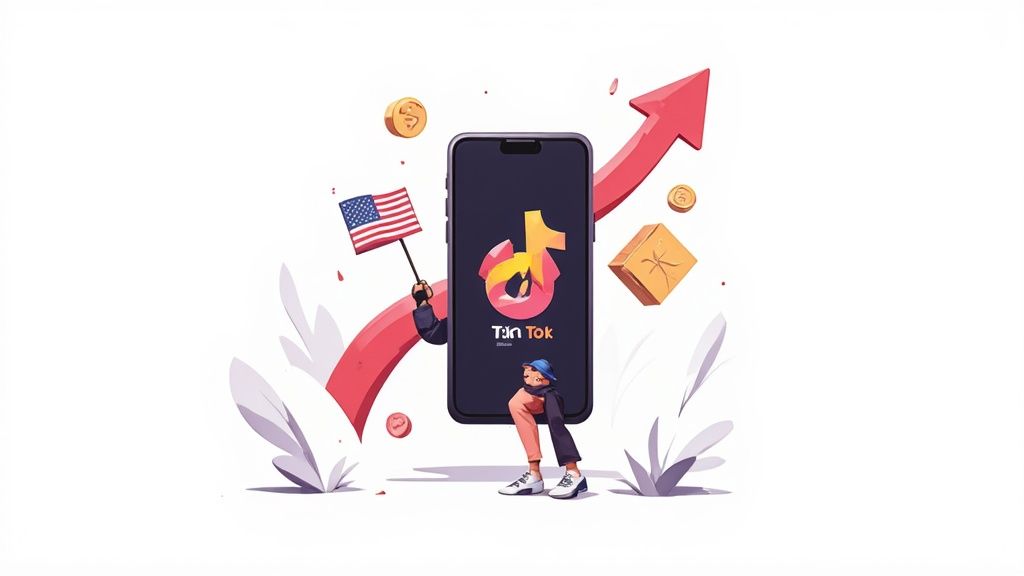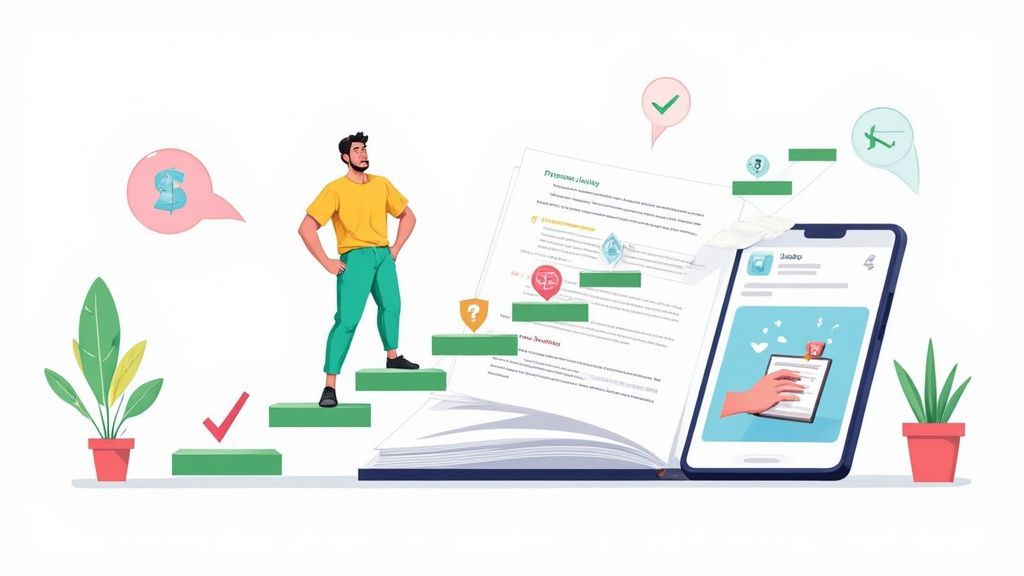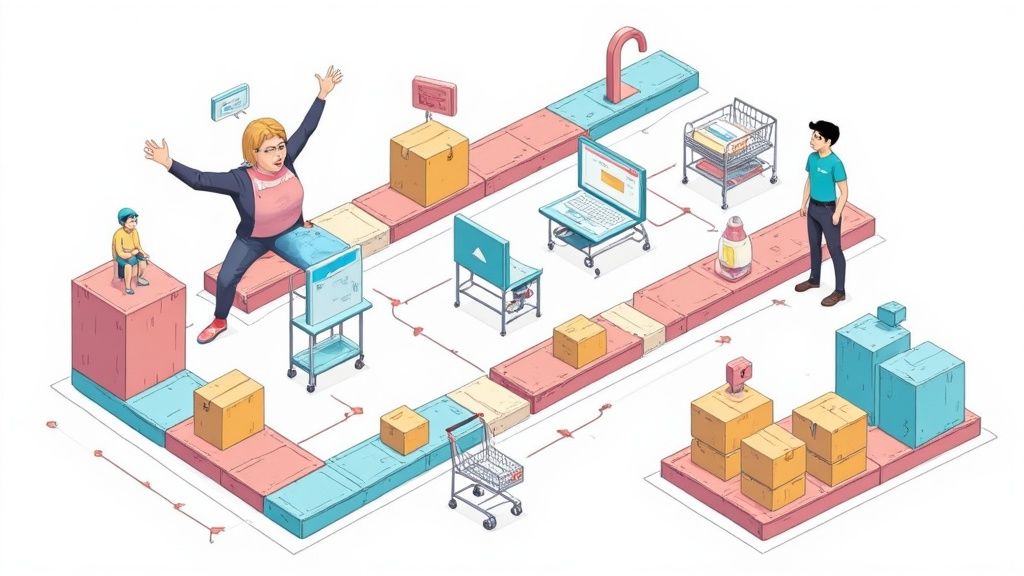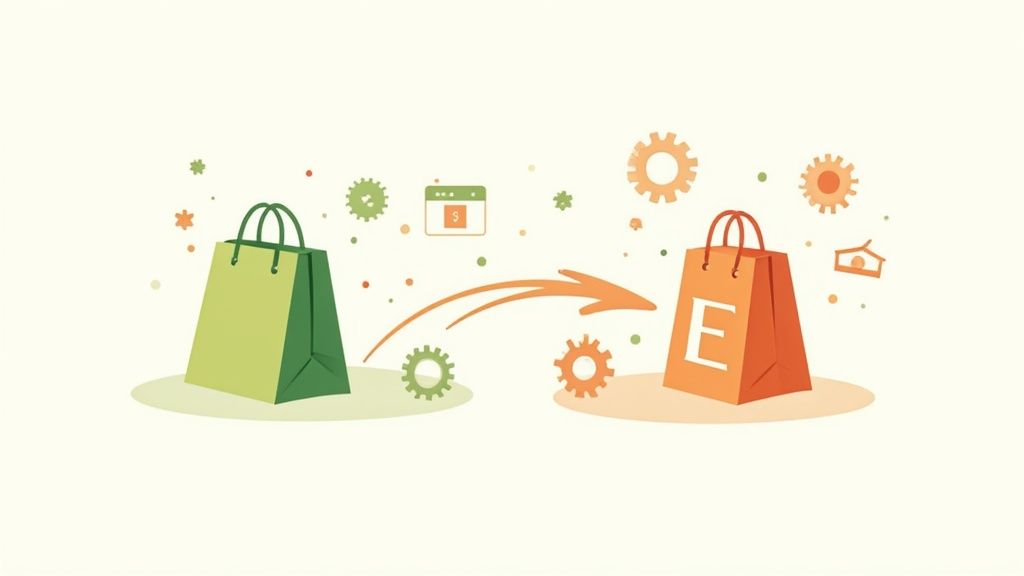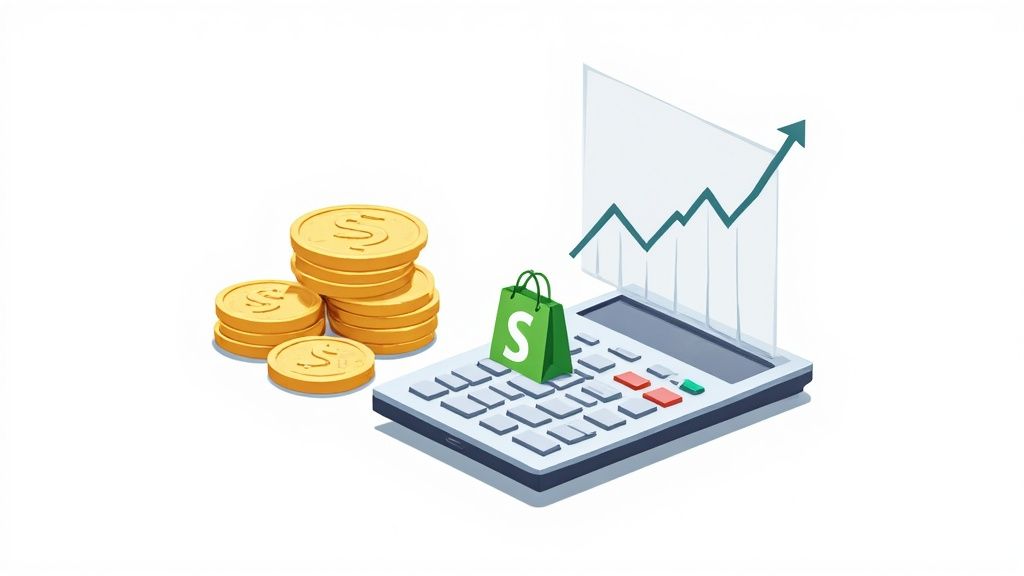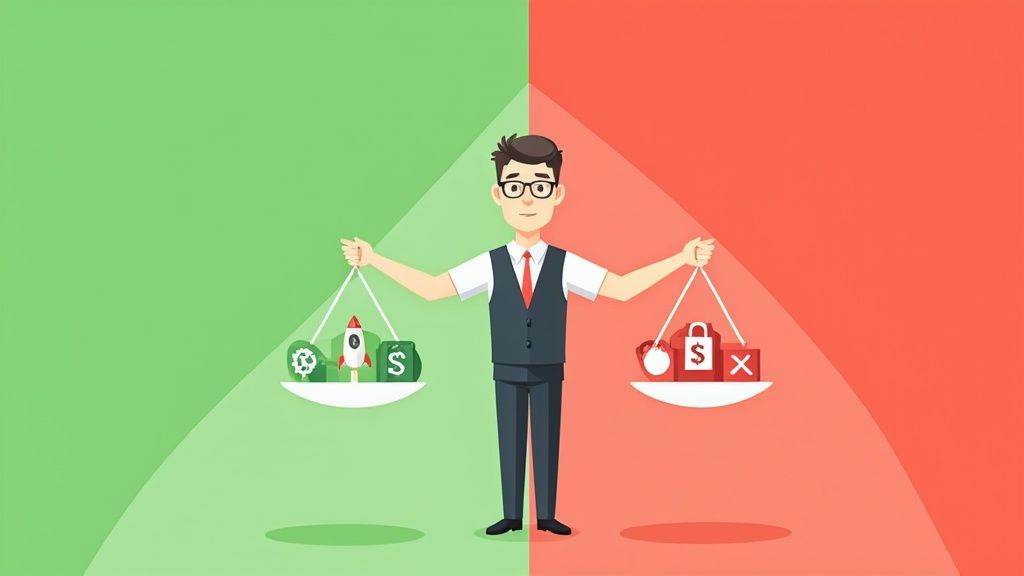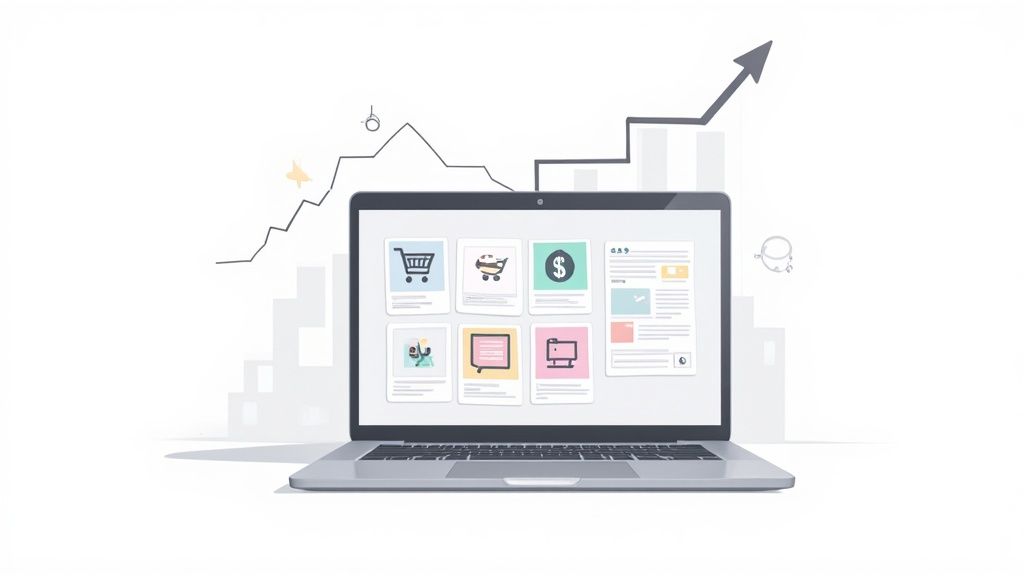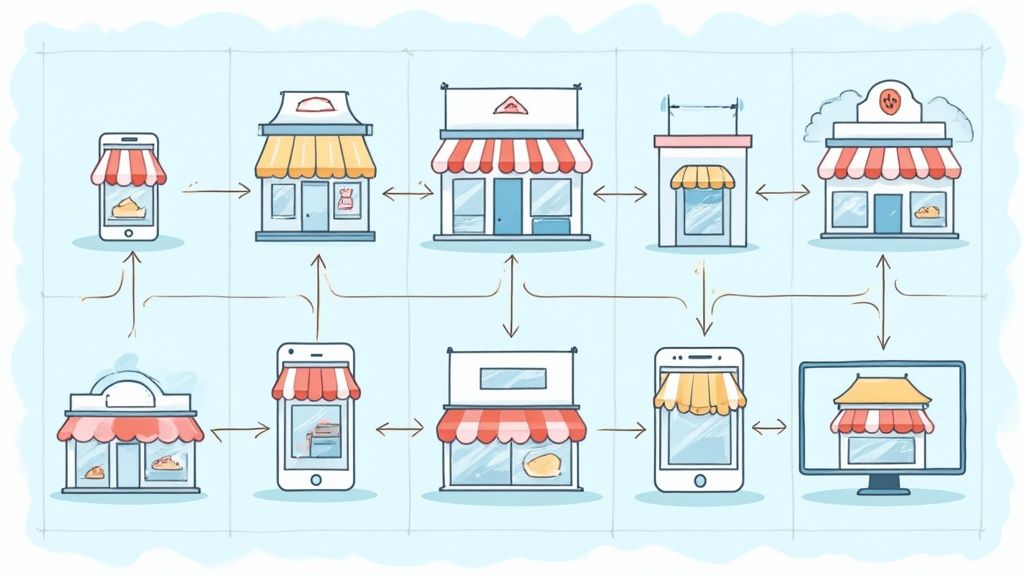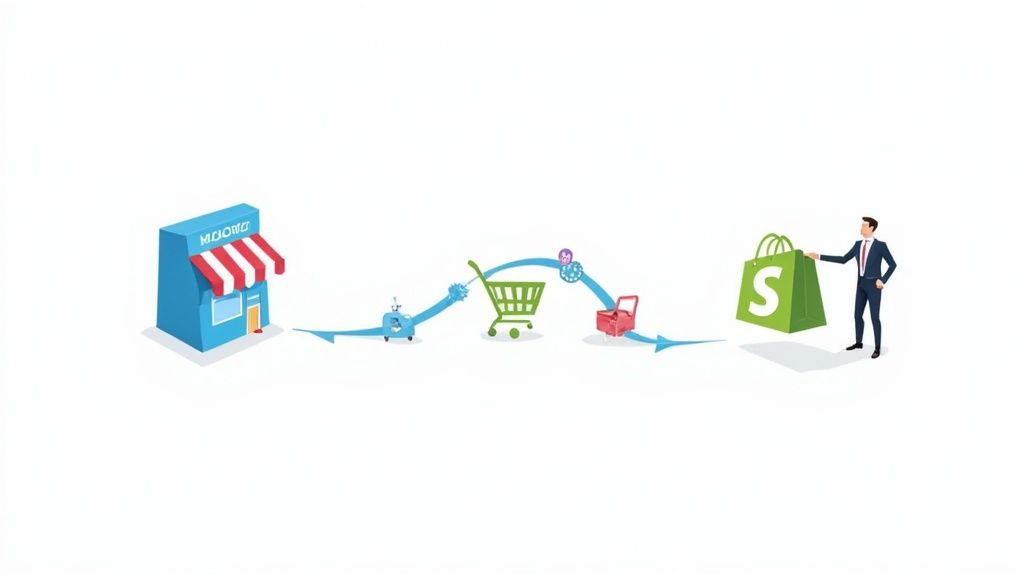
Protecting Your Bottom Line from Trump-Era Tariffs
Trump-era tariffs still impact your bottom line. This listicle provides six actionable strategies to avoid Trump tariffs and protect your profits in 2025 and beyond. Learn how supply chain restructuring, tariff engineering, first-sale rule utilization, foreign trade zones, duty drawback programs, and strategic product staging can help your business navigate international trade complexities and maintain a competitive edge. Whether you're a growing brand or an established Shopify Plus merchant, these tactics can make a significant difference.
1. Supply Chain Restructuring
One of the most effective ways to avoid Trump-era tariffs is through supply chain restructuring. This involves reconfiguring your global supply chains to source materials and manufacture products from countries not subject to these tariffs. This often means shifting production away from China to alternative manufacturing hubs in Southeast Asia, Mexico, or other regions with favorable trade relationships with the US. This proactive approach offers a long-term solution to navigate trade barriers and optimize your global operations for sustained growth.

The infographic above visualizes the process of supply chain restructuring to mitigate tariff risks. It starts with assessing the current supply chain's exposure to tariffs, then moves to identifying alternative sourcing locations. The next step involves evaluating the potential new suppliers in terms of cost, quality, and reliability. After selecting new suppliers, businesses need to adapt their logistics and operations for the new supply chain structure. Finally, ongoing monitoring and optimization ensure the restructured supply chain remains efficient and resilient. As shown, a well-planned restructuring can transform a vulnerability into a competitive advantage.
This strategy isn't just about finding the cheapest alternative; it's about building a more resilient and agile supply chain. Features of supply chain restructuring include complete or partial relocation of manufacturing operations, developing new supplier relationships in non-tariffed countries, diversifying the supply chain across multiple countries to reduce risk, and implementing a 'China+1' or 'China+N' strategy. This latter approach allows companies to maintain some Chinese operations while strategically expanding elsewhere.
This method deserves its place on this list because it offers a permanent solution that creates long-term tariff immunity. It often results in more resilient, diversified supply chains, can provide access to new markets and lower-cost labor pools, and may qualify your business for preferential trade agreements with the US.
Pros:
- Permanent tariff immunity: Sidesteps the issue entirely.
- Resilient supply chains: Reduces dependence on a single country.
- New markets and lower costs: Opens up new opportunities for growth and efficiency.
- Potential for preferential trade agreements: Unlocks additional benefits.
Cons:
- High implementation costs and time: Requires significant upfront investment.
- Potential quality control issues: Working with new suppliers requires diligent oversight.
- Loss of economies of scale: Moving away from established operations can impact initial efficiency.
- Requires significant management resources and expertise: Demands dedicated focus and skilled personnel.
Examples of Successful Implementation:
- Apple: Accelerated diversification by increasing production in Vietnam and India.
- Samsung: Shifted significant manufacturing capacity from China to Vietnam.
- Hasbro: Moved production from China to Vietnam, India, and Mexico.
- Brooks Running: Relocated running shoe production from China to Vietnam.
Actionable Tips:
- Phased approach: Begin by moving the highest-tariff products first.
- Thorough due diligence: Investigate new manufacturing locations and suppliers comprehensively.
- Supplier development: Invest in building strong relationships and ensuring quality standards.
- Regional supply chains: Consider serving both US and local markets from new locations.
- Review trade agreements: Ensure new locations offer genuine tariff advantages.
When and Why to Use This Approach:
Supply chain restructuring is ideal for businesses significantly impacted by Trump-era tariffs and seeking a long-term, strategic solution. It’s particularly relevant for companies with substantial manufacturing operations in China and those looking to build more resilient and diversified supply chains. While it’s a resource-intensive undertaking, the long-term benefits of tariff immunity and increased agility often outweigh the initial costs.
This video further explores the complexities of supply chain restructuring and offers insights into successful strategies.
This approach has been popularized by multinational corporations like Apple, Samsung, and Nike, and advocated by management consulting firms such as McKinsey, BCG, and Deloitte, as well as various trade associations. They recognize the strategic importance of adapting to the changing global trade landscape and building resilient supply chains for the future.
2. Tariff Engineering
Tariff engineering is a strategic approach to mitigating the impact of tariffs, specifically those imposed during the Trump administration (though the principles apply to any tariffs). It involves legally modifying products or their classification to reduce or eliminate tariff exposure. This isn't about evading tariffs; it's about smart, compliant maneuvering within the existing tariff code system. Essentially, it leverages the intricacies of the Harmonized Tariff Schedule (HTS) to find classifications with lower tariff rates, often by making minor alterations to the product itself, its composition, or how it's shipped.

This method can be particularly effective for eCommerce businesses, established brands, and growing companies reliant on imported goods, offering a way to maintain competitive pricing and profit margins despite increased tariffs. Tariff engineering deserves a place on this list because it offers a legal and often cost-effective solution to navigate complex trade regulations. Instead of upending your entire supply chain, which can be time-consuming and expensive, tariff engineering often requires only minor adjustments. This makes it an attractive option for businesses of all sizes seeking to avoid Trump-era tariffs (or any tariffs for that matter).
Features of tariff engineering include:
- Redesigning products: This could involve minor alterations to functionality or appearance to qualify for a different HTS code.
- Altering product composition: Slight changes to ingredient percentages or materials used can shift the product's classification.
- Breaking down finished products: Shipping components separately and assembling them later in the destination country can sometimes result in lower overall tariffs.
- Expert consultation: Working with customs experts is crucial for identifying optimal product classifications and ensuring compliance.
Pros:
- Faster implementation: Compared to supply chain restructuring, tariff engineering can be implemented relatively quickly.
- Minor modifications: Often, only small changes to the product are necessary.
- Legally sound: When executed transparently and in accordance with regulations, tariff engineering is completely legal.
- Maintain existing production: Businesses can potentially retain their current manufacturing relationships while significantly reducing tariff exposure.
Cons:
- Specialized knowledge: Requires expertise in tariff codes and customs regulations.
- Risk of challenges: Customs authorities might challenge classifications if changes are deemed insufficient.
- Potential legal disputes: Disagreements over proper classification can lead to legal disputes.
- Product compromises: Modifications might necessitate compromises in product design or performance.
Examples:
- Bicycle manufacturers adding specific functional features to their bikes to classify them under a different category with lower tariffs.
- Ford reclassifying its Transit Connect vehicles imported from Turkey as passenger vehicles instead of cargo vans to avoid the 25% "chicken tax."
- Food manufacturers subtly adjusting ingredient percentages to shift their products into a more favorable tariff category.
- Electronics companies shipping components separately from the finished product to optimize tariff treatment.
Tips for Implementing Tariff Engineering:
- Consult experts: Work with customs attorneys and tariff experts to ensure compliance and identify opportunities.
- Document everything: Maintain thorough records justifying your classification decisions.
- Consider customer impact: Evaluate how modifications might affect product performance and customer satisfaction.
- Cost-benefit analysis: Weigh the costs of redesign against the potential tariff savings.
- Stay updated: Keep abreast of changes to tariff classifications and rulings.
By understanding and strategically applying the principles of tariff engineering, businesses can effectively navigate complex trade regulations and minimize the financial impact of tariffs. This proactive approach can provide a significant competitive advantage in today's global marketplace.
3. First-Sale Rule Utilization: Slashing Tariff Costs Legally
One powerful strategy to avoid Trump tariffs and significantly reduce import costs is leveraging the First-Sale Rule. This customs valuation method allows importers to base their duty payments on the initial sale price (typically the factory price) within a multi-tiered transaction, rather than the potentially inflated price paid to a middleman. This can lead to substantial savings, as tariffs are calculated on a lower value. For businesses seeking ways to avoid Trump tariffs, this presents a legal and effective solution.
How it Works:
In many international supply chains, goods pass through multiple hands before reaching the importer. A product might be manufactured in China, sold to a trading company in Hong Kong, and then finally sold to the US importer. Traditionally, customs duties would be assessed on the price the importer paid to the Hong Kong trader. The First-Sale Rule, however, allows the importer to declare the price paid by the Hong Kong trader to the Chinese manufacturer – the "first sale" – if specific criteria are met. This lower price base can dramatically reduce the amount of tariffs paid.
Examples of Successful Implementation:
Several industries have successfully employed First-Sale Rule utilization to avoid Trump tariffs:
- Apparel Retailers: A clothing company importing from China through a Hong Kong intermediary can leverage the First-Sale Rule to pay duties based on the factory price paid by the Hong Kong company, not the marked-up price they pay to the intermediary.
- Electronics Importers: Importers of electronic components assembled in China can document the initial factory price of those components, even if they purchase them through a distributor, leading to lower tariff assessments.
- Footwear Companies: Complex footwear manufacturing and distribution chains often involve multiple intermediaries. Applying the First-Sale Rule can simplify the valuation process and minimize tariff burdens.
- Luxury Goods Companies: By separating manufacturing costs from brand premiums and utilizing First-Sale, luxury goods companies can reduce their tariff burden on the manufacturing portion of their product cost.
Actionable Tips for Implementation:
- Expert Consultation: Conduct a thorough review of your transaction structure with experienced customs experts to determine First-Sale Rule applicability.
- Binding Rulings: Secure a binding ruling from US Customs and Border Protection (CBP) before implementing First-Sale valuation to confirm its acceptability in your specific scenario.
- Meticulous Documentation: Maintain comprehensive documentation of all transactions within your supply chain, including invoices, purchase orders, and payment records, demonstrating the first-sale price.
- Supplier Cooperation: Ensure your suppliers, including intermediaries, are willing to provide the necessary documentation and transparency for First-Sale valuation.
- Regular Compliance Reviews: Implement a system of regular compliance reviews to maintain the integrity of your First-Sale program and minimize the risk of customs audits.
Pros and Cons:
Pros:
- Significant Tariff Reduction: Potential tariff cost savings average 10-20%.
- Supplier Consistency: No need to change existing suppliers or product specifications.
- Ongoing Savings: Provides continuous cost benefits for established supply chains.
- CBP Compliant: Fully compliant with US Customs regulations when properly documented.
Cons:
- Complex Documentation: Requires rigorous documentation of the entire supply chain.
- Supplier Dependence: Necessitates cooperation from overseas suppliers and intermediaries.
- Potential for Scrutiny: May attract increased scrutiny and audits from CBP.
- Limited Applicability: Not suitable for all transaction structures.
Why First-Sale Deserves a Spot on This List:
In the face of escalating tariffs, the First-Sale Rule offers a legitimate and powerful mechanism for businesses to reduce import costs without compromising their supply chains. By understanding and correctly implementing this strategy, companies can achieve significant, ongoing savings while remaining compliant with US Customs regulations. This makes it a vital tool for any business seeking to mitigate the impact of trade disputes and maintain a competitive edge in the global market. While complexity exists, the potential savings make it a worthwhile pursuit for eligible businesses. This method has been championed by major global trade compliance firms like Sandler, Travis & Rosenberg, Ernst & Young, KPMG, and industry groups such as the US Fashion Industry Association, further solidifying its legitimacy and efficacy in helping businesses avoid Trump tariffs.
4. Foreign Trade Zones Utilization
Navigating the complexities of international trade can be challenging, especially when tariffs threaten to impact your bottom line. One effective strategy to potentially avoid Trump tariffs and other import duties is utilizing Foreign Trade Zones (FTZs). These designated geographic areas within the United States operate under special customs regulations, effectively considered outside U.S. customs territory for duty payment purposes. This unique status allows companies to defer, reduce, or even eliminate duties on imported goods, offering significant advantages for businesses engaged in international trade. This strategy is particularly relevant for emerging eCommerce businesses, growing brands, and established Shopify Plus stores dealing with imported goods, offering a potential avenue for substantial cost savings.

FTZs offer several key features that make them a powerful tool for mitigating tariff impacts. Businesses can defer duty payments until the goods actually enter U.S. commerce, improving cash flow and providing flexibility. Furthermore, companies have the option to pay duties on either the imported components or the finished products, whichever is lower. This can be a game-changer for manufacturers, allowing them to strategically minimize their duty burden. Finally, duties are entirely eliminated on goods or materials that are re-exported, making FTZs particularly attractive for businesses involved in global supply chains.
Pros of Utilizing FTZs:
- Duty Elimination/Reduction: Eliminate duties on waste, scrap, and rejected materials, and potentially reduce overall duties based on the finished product vs. component valuation.
- Improved Cash Flow: Defer duty payments until goods enter the U.S. market.
- Reduced Fees: Reduce merchandise processing fees through consolidated weekly entry filings.
- Ideal for High-Duty Items: Maximizes benefits for businesses importing goods subject to high tariffs.
- Benefits for Manufacturing: Streamlines import processes and potentially reduces costs for manufacturing operations.
Cons of Utilizing FTZs:
- Application Process: Requires a formal application and approval process, which can be time-consuming.
- Setup & Compliance Costs: Involves initial setup costs and ongoing compliance requirements.
- Geographic Limitations: Limited to designated FTZ locations, which may not be convenient for all businesses.
- Complex Inventory Tracking: Requires robust inventory tracking systems to satisfy customs regulations.
Examples of Successful FTZ Implementation:
- Tesla: Utilizes FTZ status at its Fremont, California factory to manage import duties on components.
- Samsung: Operates within an FTZ in Newberry, South Carolina for home appliance manufacturing.
- BMW: Leverages extensive FTZ utilization at its Spartanburg, South Carolina plant.
- Oil Refineries: Commonly use FTZs to manage duties on imported crude oil.
Actionable Tips for Businesses:
- Cost-Benefit Analysis: Conduct a thorough cost-benefit analysis considering your specific import profile and product categories.
- Location Considerations: Evaluate proximity to existing FTZs or explore the possibility of applying for a new subzone.
- Inventory Tracking: Implement a robust inventory tracking system that meets all customs requirements.
- Prioritize High-Duty Items: Start by utilizing FTZs for your highest-duty items to maximize initial benefits.
- Consult with Experts: Work with experienced FTZ consultants to navigate the application and compliance processes.
Foreign Trade Zones deserve a place on this list because they offer a legitimate and potentially powerful mechanism for businesses, especially eCommerce companies dealing with imported goods, to mitigate the impact of tariffs. By understanding the features, benefits, and requirements of FTZs, businesses can make informed decisions about whether this strategy aligns with their overall import/export operations and financial goals. While there are administrative hurdles to overcome, the potential cost savings and operational advantages make FTZ utilization a valuable tool in today's complex global trade environment. Unfortunately, a central website for the National Association of Foreign Trade Zones isn't readily available, but information can be found through various port authorities and economic development agencies.
5. Duty Drawback Programs: Reclaiming Duties to Offset Trump-Era Tariffs
Navigating the complexities of international trade, especially in the wake of the Trump-era tariffs, can significantly impact your bottom line. One powerful tool to mitigate these costs and potentially recover a substantial portion of paid duties is the U.S. Customs and Border Protection's (CBP) Duty Drawback Program. This program allows you to claim refunds of up to 99% of duties, taxes, and fees paid on imported merchandise that is subsequently exported or destroyed under customs supervision. This makes it a valuable strategy to avoid Trump tariffs and improve your overall profitability.
How Duty Drawback Works:
The core principle of duty drawback is relatively simple: if you import goods and then export them (either in their original form or after being incorporated into other products), you shouldn't have to pay duties on the imported components. The program facilitates this by providing a mechanism for claiming refunds on those duties. There are several types of drawback, including:
- Direct Identification Drawback: Used when imported goods are exported in the same condition.
- Manufacturing Drawback: Applies when imported materials are used in the manufacturing of exported goods.
- Substitution Drawback: Allows for the refund of duties paid on imported goods when similar domestically produced goods are exported. This option gained greater flexibility thanks to the Trade Facilitation and Trade Enforcement Act (TFTEA).
When and Why to Use Duty Drawback:
Duty drawback is particularly relevant for businesses engaged in both import and export activities. If your business model involves importing raw materials or components, processing or incorporating them into finished products, and then exporting those products, duty drawback can provide significant cost savings. It's also valuable if you import goods that are ultimately destroyed under CBP supervision. This approach can help avoid Trump tariffs by effectively reducing the landed cost of imported materials designated for export.
Examples of Successful Implementation:
- Chemical Manufacturers: Importing raw materials, processing them into specialized chemicals, and then exporting these finished products.
- Aerospace Companies: Importing components, assembling them into aircraft, and exporting the completed planes.
- Electronics Manufacturers: Utilizing imported components in products destined for both domestic and export markets.
- Oil Refineries: Importing crude oil, refining it into various petroleum products, and exporting these refined products.
Pros:
- Significant Tariff Recovery: Recoup up to 99% of previously paid duties, taxes, and fees.
- Supply Chain Integration: Works with existing supply chains without requiring major restructuring.
- Enhanced Flexibility: The TFTEA modernized the program, particularly with substitution drawback.
Cons:
- Complex Documentation: Requires meticulous record-keeping and tracking of imported and exported goods.
- Administrative Burden: The process can be time-consuming and require specialized expertise.
- Limited Applicability: Only applies to goods that are exported or destroyed under CBP supervision.
- Processing Time: Refunds can take time to process.
Actionable Tips for Utilizing Duty Drawback:
- Robust Tracking Systems: Implement systems that seamlessly connect import and export documentation.
- Expert Assistance: Consider partnering with specialized drawback service providers like C.H. Powell or Comstock & Theakston. These firms can navigate the complexities of the program and maximize your refunds.
- Detailed Record-Keeping: Maintain comprehensive records of manufacturing processes involving imported materials.
- Electronic Filing: Utilize the Automated Commercial Environment (ACE) for electronic claim filing.
- Compliance: Ensure strict adherence to the specific drawback provisions being claimed.
Duty drawback offers a valuable opportunity to avoid Trump tariffs and recapture a significant portion of import duties. While the process can be complex, the potential financial benefits make it a worthwhile strategy for businesses involved in international trade. By understanding the intricacies of the program and implementing the tips provided, you can effectively leverage duty drawback to improve your bottom line.
6. Strategic Product Staging
Strategic product staging is a tactical approach to managing imports and exports in the face of fluctuating tariffs, specifically those implemented during the Trump administration. It involves carefully timing your shipments to minimize or avoid tariff expenses. This means accelerating imports before tariffs are implemented, delaying shipments while trade negotiations are ongoing, or utilizing bonded warehouses to store goods temporarily until trade conditions become more favorable. This strategy allows businesses to take advantage of periods of lower tariffs or avoid them altogether, maximizing profitability and maintaining a competitive edge.

This method deserves its place on the list because it's a relatively straightforward way to mitigate the impact of tariffs, especially in the short term. Unlike complex restructuring of your supply chain, strategic product staging focuses on timing and logistics, making it accessible to businesses of various sizes and complexities. It offers the flexibility to adapt to the changing landscape of international trade policy without requiring drastic operational overhauls. Key features include timing imports to sidestep announced but not-yet-implemented tariffs, leveraging bonded warehouses to defer duty payments, strategically positioning inventory across global locations for routing flexibility, and accelerating or delaying orders based on tariff expectations.
Examples of Successful Implementation:
- Retail Giants: Major retailers like Target and Walmart accelerated holiday merchandise imports to beat impending tariff deadlines, ensuring product availability and cost-effectiveness for the crucial holiday shopping season.
- Tech Companies: Apple strategically timed component shipments from China to avoid tariff increases, maintaining their product margins.
- Industrial Materials: Steel importers stockpiled inventory before Section 232 tariffs went into effect, shielding themselves from the initial price hikes.
- Furniture Retailers: Furniture retailers utilized bonded warehouses during trade negotiations, allowing them to hold imported goods without incurring immediate duty costs while awaiting the outcome of the talks.
Pros:
- Tariff Avoidance: Properly timed shipments can completely eliminate tariff expenses.
- Simplicity: Compared to restructuring your supply chain, this is a relatively simple strategy to implement.
- Flexibility: Provides agility to respond to evolving trade policies.
- Time-Buying: Offers time to develop and implement longer-term solutions.
Cons:
- Short-Term Solution: Strategic product staging is a temporary fix, not a permanent solution.
- Inventory Costs: Increased inventory holding expenses, including warehousing and potential obsolescence, can offset tariff savings.
- Risk of Obsolescence: Stockpiling carries the risk of holding onto products that become outdated.
- Supply Chain Disruptions: Uneven ordering patterns can disrupt the supply chain, potentially impacting production schedules and customer fulfillment.
Actionable Tips for Ecommerce Businesses:
- Monitor Trade Policy: Closely follow trade news and policy developments to anticipate potential tariff changes.
- Contingency Planning: Develop contingency plans for different tariff scenarios to maintain operational flexibility.
- Cost-Benefit Analysis: Weigh potential tariff savings against the increased inventory carrying costs.
- Warehouse Capacity: Consider expanding warehouse capacity temporarily to accommodate pre-tariff stockpiling.
- Supplier Communication: Maintain open communication with suppliers regarding flexible delivery scheduling to facilitate timely adjustments.
This strategy is particularly relevant for emerging eCommerce businesses, growing brands with significant monthly revenue, established brands on Shopify Plus, and any business seeking eCommerce consulting and optimization. By effectively implementing strategic product staging, these businesses can navigate the complexities of international trade and maintain a competitive advantage in the face of evolving tariff landscapes.
6 Strategies to Avoid Tariffs Comparison
Thriving in a Post-Tariff Landscape
Navigating the complexities of international trade in the wake of Trump-era tariffs can feel like a daunting task. However, by understanding and implementing the strategies outlined in this article – supply chain restructuring, tariff engineering, leveraging the first-sale rule, utilizing foreign trade zones, exploring duty drawback programs, and strategic product staging – you can effectively mitigate the impact of these tariffs and even unlock new opportunities for growth. The key takeaway is that a proactive and informed approach is crucial. Choosing the right combination of these strategies, tailored to your specific business needs, empowers you to not only avoid tariffs but also optimize your supply chain for increased efficiency and profitability.
While navigating the complexities of tariffs can be challenging, it's also an opportune time to consider broader financial security measures. Implementing robust asset protection strategies can help safeguard your wealth from various threats, creating a more resilient financial foundation. These strategies, as outlined by America First Financial in their insightful article "8 Asset Protection Strategies for 2025", can provide additional peace of mind as you navigate the intricacies of international trade.
Mastering these concepts is essential for any business engaged in global commerce, especially emerging eCommerce businesses, growing brands, and established Shopify Plus merchants. By minimizing the financial burden of tariffs, you can free up resources for reinvestment in your business, ultimately driving further expansion and success. In the ever-evolving landscape of international trade, adaptability is key to not just surviving, but thriving.
Ready to optimize your supply chain and navigate the complexities of international trade? ECORN specializes in Shopify and scalable eCommerce solutions, helping businesses like yours mitigate the impact of tariffs and build a more resilient future. Connect with ECORN today to explore how we can help you thrive in a post-tariff world.














